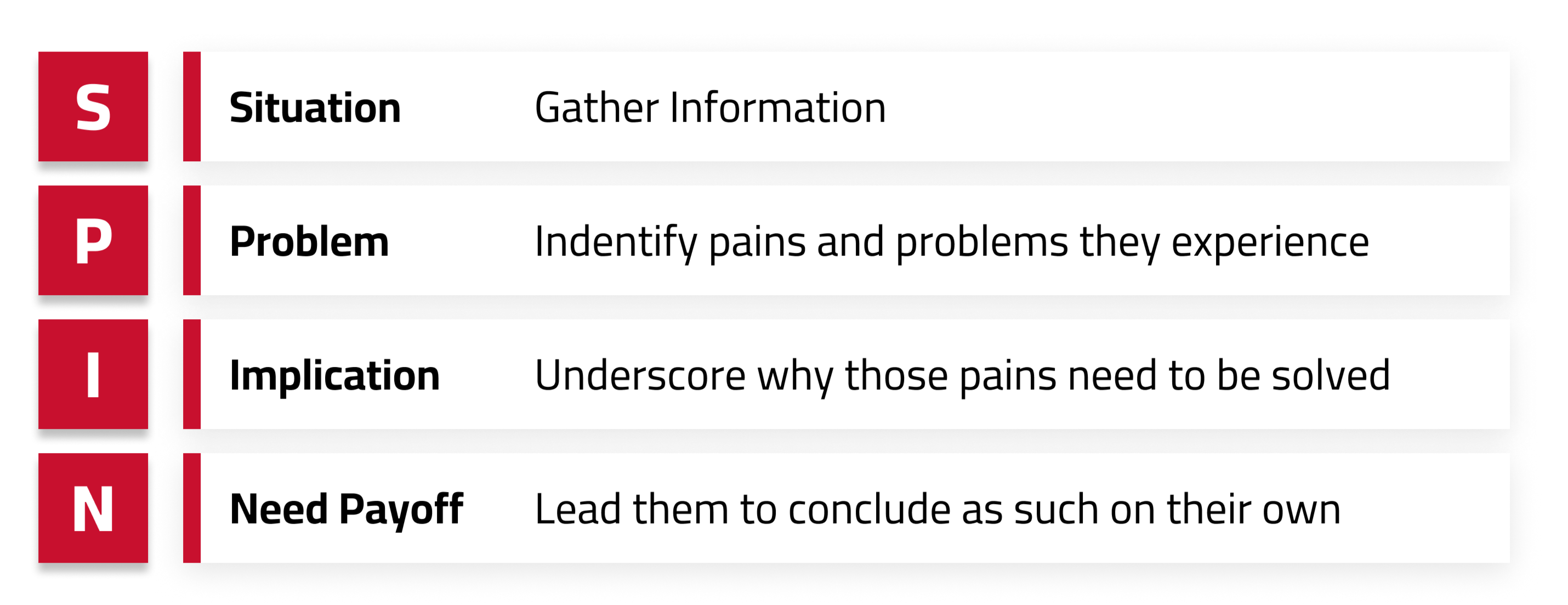Based on extensive observational research and analysis of sales behaviours, SPIN Selling enables salespeople to acquire a deeper understanding of their customer’s needs, build a persuasive case around specific problems and provide effective solutions.
Created and developed here at Huthwaite International, SPIN Selling continues to be one of the most iconic and widely used sales methodologies across the globe - crossing cultural boundaries and evolving with changing customer behaviour.
As the creators of SPIN Selling, in this guide, we’ll explain everything you need to know about this timeless approach to sales success.
Discover the science behind SPIN Selling. Rapidly implement the four-stage questioning framework used by top sales professionals with our complimentary whitepaper: The Science behind SPIN Selling.
What is SPIN Selling?
SPIN Selling is the world’s leading sales methodology, as outlined in Neil Rackham’s groundbreaking book ‘SPIN Selling’ first published in 1988.
Effective sellers focus on the customer’s buying process, not on their own sales process. The Buying Cycle outlines the key phases that customers go through when deciding whether or not to buy.
Depending upon where customers are in the Buying Cycle, they may or may not volunteer their needs and we might have to uncover them actively, using questions.
Why SPIN selling?
What are the benefits of SPIN Selling?
When compared to traditional sales methods, SPIN Selling adopts a more human-centric approach, builds stronger business relationships, and facilitates a sales process that’s more efficient.
Building a strong relationship with customers paves the way for companies to offer services that are relevant to customer needs, leading to improved conversion rates, more lucrative deals, and lower levels of customer churn.
SPIN questions  The SPIN Selling method is built around four types of SPIN questions, with each fulfilling a specific role in the sales process:
The SPIN Selling method is built around four types of SPIN questions, with each fulfilling a specific role in the sales process:
-
Situation: questions about the customer’s current situation
-
Problem: questions about the customer’s difficulties or dissatisfactions
-
Implication: questions about the consequences or implications of the customer’s problems
-
Need-Payoff: questions that explore the importance to the customer of solving a problem
These SPIN questions provide a logical framework rather than a rigid sequence allowing salespeople to enhance communication with their prospects, deliver value and close more deals. They steer the conversation away from the salesperson, to focus on customers and their needs.
Crucially, SPIN Selling isn’t simply a technique that you can read about and apply easily alongside other sales tactics as a quick way to win more deals.
The success of SPIN selling is dependent on proper training, coaching, application, and most importantly, a commitment to changing the long-term behaviour of you and your team. Refining key skills, such as building strong customer relationships, and learning how to present persuasively, is crucial.
Examples of SPIN questions
Situation
You need to stop talking and start listening to your buyer’s needs and understand what their current issues are.
At Huthwaite International, our sellers can create a well-rounded picture of the buyer’s current difficulties by asking the following questions:
-
What is the sales team's target this quarter?
-
Have you had previous sales training?
-
What are the biggest challenges faced by your organisation concerning the sales team?
These questions are about your services but are used to indicate what SPIN questions to ask next.
Problem
The seller should ask SPIN questions to anticipate potential challenges the buyer may be currently experiencing.
Going back to the previous example, the buyer told us that they have offices in four cities in Europe and grew rapidly in the last year. No one in their company has had any formal training, and their sellers aren’t hitting their targets. Potential questions we could ask in this situation are:
-
What concerns do you have with the potential volume of missed business opportunities when trying to meet your sales targets?
-
What problems are you experiencing with your globally spread sales team?
The seller can use these answers to inform the implication questions by delving deeper into their issue to not only discuss the present, but the future.
Implication
The seller needs to discuss the impact current issues could have on the buyer’s business long-term if their situation stays the same.
Returning to the Huthwaite International scenario, it’s clear to the seller that if the buyer doesn’t properly train their sales team, the business will not hit its core KPIs.
As a result, the growth that the business has faced in the last year will plateau and begin to decline. Potential questions the seller could ask to get more information are:
-
If your team does not hit their targets, would this lower overall market share in your field and increase the risk of competition?
-
What consequences do you see by not implementing a consistent sales methodology?
Now, the seller will have enough information to create a personalised pitch to the buyer, enabling us in this example to illustrate the positive impact our services can offer.
Need-payoff
The seller needs to show how their current situation and future challenges can be solved, using your service as the best solution to their present and future challenges.
Using the Huthwaite International example, the seller will now fully understand the long-term effects their company will face if they do not adequately educate and train their sales team. Now it’s time to pitch our service as a solution. The seller can lead into the pitch by asking questions such as:
-
If your sales team had the confidence to delve deeper and explore opportunities, what value would this have on long-term customer retention?
-
If you could instil a behaviour change mindset using a well-researched sales methodology, how would that help your strategic business direction?
These SPIN questions are aspirational. The seller isn’t giving the buyer a direct answer, but helping them imagine the benefit of a product or service like theirs could bring.
This is a common theme throughout all the SPIN questions you can ask; the seller learns from the buyer about their issues, enabling them to pitch their product or service tailored to the buyer's specific needs.
By asking the buyer about their current situation, day-to-day issues, and the potential long-term effects, it allows the seller to pitch their product or service as a solution that will solve their present or future issues. This piques the buyer’s interest, making them feel like they’re being listened to and that the seller understands what they need from a solution.
Why SPIN Selling works: The Science Behind the Method
In the early 1970s, Neil Rackham and his team set out to uncover what really made top salespeople the best. Were they more charismatic? Was it in their genetics?
Out of 35,000 sales calls came the answer, and SPIN Selling was created. The findings of this revolutionary study - the largest of its kind - were very telling. In fact, they dispelled numerous, popular sales practices and myths, with the most important findings being that:
-
All customer needs are different. This seems obvious, however what we mean here is that focusing on the ‘features and benefits’ of a product or a service isn’t going to work unless they are linked to specific customer needs.
-
Closing techniques are actually counterproductive to the sales process. Skilled sellers explore their customer needs in depth, demonstrate their capability to meet those needs and show a clear business case for their solution before they attempt to close the sale.
-
Great salespeople are most definitely made, not born! Customers demand empathy and integrity. Successful salespeople work hard to become considered and skilled professionals that their customers can trust to provide them with great solutions to their challenges.
Most importantly, it isn’t the appearance or charm of salespeople that helps them close deals - but their behaviours.
In observing what top performers said and did within a sales call, the Huthwaite research group pioneered the use of a research tool, now widely known as Behaviour Analysis. By monitoring and observing how top performing salespeople acted, the team found which behaviours were synonymous with successful outcomes in various scenarios.
We call this a Success Model, and at Huthwaite International, we train salespeople to modify their existing behaviour to match it. Our training focuses on the individual components that make certain behaviours successful, and mirrors this through interactive role plays and skills transfer sessions that allow skills to be used in the workplace.
SPIN Selling case studies
The SPIN Selling sales methodology continues to bring great success to businesses.
Here at Huthwaite International, we have countless stories of how SPIN Selling has created lasting impact for our clients:
-
Scientifica used SPIN Selling to convert more opportunities
-
Medtronic used SPIN Selling to build trust in their Inside Sales team and improve customer confidence
-
Essity aligned its sales and marketing skills with sustainability efforts
You can also view all of our case studies here.
Is SPIN Selling still relevant?
Although SPIN Selling was created over 30 years ago, its teachings are perhaps more relevant than ever before, prompting many companies to embrace these in-person and virtual communications.
Today, prospects have a lot more choices and a wealth of information at their disposal, which means they are often less willing to engage with salespeople - the stakes are higher to make a positive and lasting impression.
What has changed is that selling as a whole is no longer just about persuading prospects, as buyers today can and will make their own decisions.
However, what does influence a buying decision is the salesperson and their behaviour. After all, many products today are commodities - what tips the scale towards a decision is the person selling, and how well they can respond to customer needs and offer value.
This makes the application of SPIN Selling skills integral to sales success - uncovering problems, solving challenges and communicating value right away.
SPIN fundamentals are especially important in the absence of face-to-face meetings, when salespeople are selling remotely and need to gather crucial information quickly.
In a world where your prospect could be speaking to multiple salespeople at once, SPIN Selling ensures you’re the one they want to do business with.
Enhance your sales performance with our SPIN Selling training plan. Achieve higher margins, shorter sales cycles, and improved customer satisfaction. Develop your training plan today.
How does the SPIN model apply to real-life scenarios?
Simply following a formula doesn’t reflect real conversations - especially when it’s increasingly uncommon that an entire sale will happen in one discussion.
With longer buying cycles and complex purchasing decisions, it’s more important than ever that salespeople do their research to enhance their sales methodology and determine where their prospect is positioned in the buying cycle.
For example, suppose a prospect is actively looking at suppliers. In that case, this indicates that they’re further along in their buying cycle - meaning that more obvious Situation questions are redundant at this stage. Asking these kinds of questions could hurt your progress, and send your prospect into the arms of another supplier.
This is especially true in the current climate; in the years since SPIN Selling was created, we’ve been able to gain crucial information about our customers online, meaning that certain questions don’t need to be asked anymore - such as company size, for example. Understanding the SPIN model and how to apply it to your prospects is key to using the methodology to your advantage.
Elevate your sales skills with our comprehensive whitepaper. Download 'Developing sales opportunities' to master the art of understanding evolving customer needs.
How to develop SPIN Selling skills
It’s natural to set high standards for your sales team. However, the hard work isn’t done when your team can confidently provide an answer to the question, ‘What is SPIN selling?’. You need to compile a list of SPIN questions and put them into practice in your sales calls.
As Neil Rackham explains in the video above, skills aren’t learned that way and there’s more that needs to be learned to reap the benefits of this sales methodology.
Like any other skill, learning to use SPIN Selling techniques well, requires time and effort. SPIN Selling can’t be taught in its entirety through a book, or blog. Being an effective salesperson or team requires more - it’s a behavioural change, that can only be accomplished through proper training and practice.
SPIN Selling training
Since SPIN Selling was created based on scientific analysis of verbal behaviour during actual sales conversations, it follows that the best way to master the skill is through interactive training.
As a business, aligning yourself to a sales methodology gives you a competitive advantage, as it allows you to establish routine and rigour within your sales strategy, as well as improving the confidence of your salespeople.
Our specialist training focuses on facilitating lasting positive change in the behaviour of your sales team. Every training programme we undertake aims to change behaviour and change results - Huthwaite’s proven behaviour-change model.
SPIN training doesn’t just teach you to ask the right questions, but how to function as a successful salesperson/team in the current climate, including:
-
Identifying new sales opportunities when your sales techniques are outdated, or prospects are no longer responding to your tactics
-
Understanding where and why sales go wrong, and how to measure success to inform future discussions
-
Building the confidence of a sales team that has been dampened by a stream of losses
-
Determining how to approach prospects in times of uncertainty, or where clients aren’t obviously searching for a solution
-
Maintaining a solid sales strategy when your sales team cannot consistently communicate in person - or they’re having to conduct sales virtually.
However, the success of training relies on not only believing in the methodology but being open and willing to embrace organisational change.
At Huthwaite International, we’ve helped many leading companies change their behaviour through tailored training, with each course designed to meet their individual sales challenges and requirements. Even in times of uncertainty, SPIN has proven to be more than worth the investment.
Free download: SPIN Evidence of Return on Investment. Discover how a software company boosted sales by 50% through SPIN sales training.
Improve your SPIN Selling skills with SPIN sales training by Huthwaite International
As the creators of SPIN Selling, Huthwaite International is a certified training provider and the only company in the world offering training in this area. We deliver a truly global programme that accounts for cultural and behavioural differences.
The scope of our international delivery is vast - managing and implementing training solutions for countless clients and helping them achieve consistency in teams across the world.
We’ve continued to enhance our courses as the economic and social climate continues to change - offering a virtual SPIN sales course when sales teams can’t gather in a classroom.
Now more than ever, the skills and behaviours taught in our SPIN Selling courses are essential to any teams involved in communicating, selling or negotiating with customers. As the world, and your customers, continue to evolve, you must invest the time and energy in meeting their needs.
- How you can develop SPIN selling skills
- how successful sellers use SPIN selling to minimise objections
- the verbal behaviours that successful sellers use to make compelling benefit statements.








.webp)